Answer these simple questions and we will find you the BEST prices
Which type of solar quotes do you need?
It only takes 30 seconds
100% free with no obligation

Get Free quotes from insulation specialists near you

Save money by comparing quotes and choosing the most competitive offer

The service is 100% free and with no obligation
- GreenMatch
- Insulation
- Wall Insulation
- External Wall Insulation
External Wall Insulation: Pros & Cons, Costs, Grants

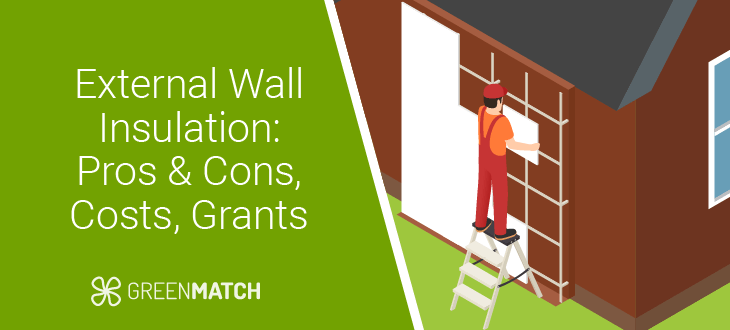
- The average external wall insulation cost for a 3-bedroom semi-detached home is approximately £11,000.
- Several grants, such as the ECO4 scheme, Warmer Homes Scotland scheme, and the Affordable Warmth scheme, are available to help cover the costs of external wall insulation.
- You can save between £140 and £700 annually on energy bills by insulating your exterior walls.
Over 21 million UK homes lack insulation, leading to 35% heat loss, making wall insulation essential for reducing energy costs. Wall insulation can save £140 to £700 annually and cut carbon emissions by 410 to 2,100 kg/CO2 yearly.
Among the various insulation options, external wall insulation is one of the most effective, especially for homes with solid walls. Although only 30% of UK homes have solid walls, a staggering 97% of these homes remain uninsulated. Exterior wall insulation is a powerful way to enhance energy efficiency for those with solid walls.
However, external wall insulation has its own set of pros and cons. It's a significant investment, with costs varying depending on your property's size and materials. Fortunately, several grants are available to help reduce the financial burden, making this energy-saving option more accessible.
In this article, we'll delve into the pros and cons of external insulation, discuss potential costs, and explore available grants to help you determine if this is the right solution for your home and budget.
Want to boost your home's energy efficiency and save on energy bills? Let GreenMatch connect you with top external insulation specialists. Fill out our quick form for up to four free quotes from top-rated installers. No hidden costs, just expert advice, and the best deals. Click below to get started!
Fill in the form in just 1 minute
- What is external wall insulation?
- Advantages and disadvantages of external wall insulation
- External wall insulation cost
- External wall insulation grants
- Materials for external insulation
- What walls are suitable for external insulation
- Building regulations for external insulation
- How to insulate external walls
- FAQ
What is external wall insulation?
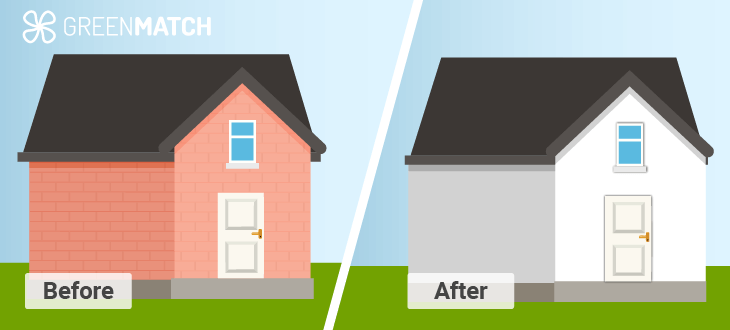
External wall insulation involves applying insulation to the exterior of your home, which is used explicitly on homes with solid walls. This method consists of several layers and includes:
- Adhesive layer: This is applied directly to the external wall while securely bonding the insulation panels.
- Insulation board: This is the core layer responsible for the actual insulation. It reduces heat loss by creating a thermal barrier between the interior of the home and the external environment.
- Reinforcement layer: This layer adds strength and durability to the insulation system, preventing cracks and other damage.
- Fixing anchor and glass mesh: The fixing anchors secure the mesh layer by being installed on the insulation boards.
- Primer: This layer helps waterproof the external wall insulation. It also helps to even out the surface and prepare it for the topcoat.
- Finishing render layer: The finishing render or cladding insulation serves an aesthetic and protective function. It provides the final look of the building's exterior. It protects the underlying layers from weathering, UV rays, and mechanical damage.
External wall insulation is typically used for solid walls, commonly found in homes built in the 1920s or earlier. You can usually identify a solid wall by the pattern of bricks on your home. Solid walls have an alternating brick pattern, with some bricks laid across the wall so that the smaller ends are visible outside.
If your home is covered in a decorative finish, there is another way to determine whether you have external walls. Using a tape measure, measure the width of your wall. If the wall is 260mm or less, you will likely have a solid wall.
Advantages and disadvantages of external wall insulation
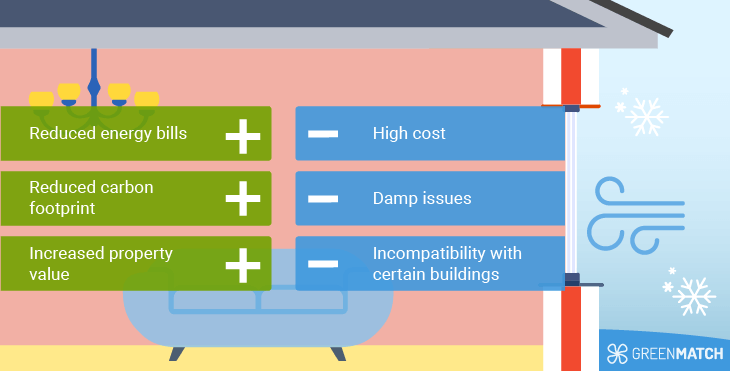
When considering external wall insulation for your home, it's essential to consider the advantages and disadvantages before deciding. Exterior wall insulation can bring significant benefits, such as improved energy efficiency and home aesthetics.
However, it's essential to be aware of potential drawbacks, including higher costs and potential disruption during installation. By carefully evaluating the pros and cons, you can decide whether this investment matches your home's needs, budget, and long-term goals.
Understanding these factors will help you make the best choice for your property's insulation needs. Here are the advantages and disadvantages of external wall insulation.
Advantages of external insulation
External wall insulation offers several advantages that can significantly improve your home's energy efficiency, comfort, and overall value. Here are some key benefits:
- Reduced energy bills: Exterior wall insulation increases energy efficiency by adding a layer of thermal protection to the exterior of your home, reducing heat loss. According to the Energy Saving Trust, this can save you between £140 and £700 annually on energy bills.
- Reduced carbon footprint: By insulating your exterior walls, you can decrease your home's energy consumption, reducing your carbon footprint by 410 to 2,100 kg/CO2 annually.
- Increased property value: By improving your home's energy efficiency, you can increase its property value by up to 14%, according to GOV.UK.
- Preserve internal floor space: By insulating the exterior of your property, you can ensure that your home's internal floor space remains unaffected.
- Protection against weathering: Exterior wall insulation provides a protective layer for your home, shielding it from the elements and reducing the risk of dampness and water infiltration.
- Soundproofing: Adding layers can help reduce outside noise, which is particularly beneficial for homes in busy urban areas or near noisy roads.
- Improve home aesthetics: By covering the exterior walls with insulation and a new finish, you can refresh your home's appearance and potentially save on future redecorating costs.
Disadvantages of external wall insulation
While external wall insulation offers numerous benefits, it's essential to consider the potential disadvantages before investing in it. Here are some key drawbacks:
- High cost: External insulation can be costly, with expenses varying based on property size, materials used, and installation complexity. The initial investment is often higher than other insulation methods, which can be challenging for those on a budget.
- Disruption during installation: Installing exterior wall insulation can be disruptive, especially if scaffolding is required or the work takes several weeks. The process may cover your home's exterior and restrict access to certain areas, causing inconvenience.
- Altered appearance of home: External insulation can improve your home's look but may not match the original style of traditional or historic properties, impacting the building's character.
- Planning permission: Depending on your location and property type, you may need permission to install external wall insulation. Contact your local authority to find out if it's required for your home.
- Damp issues: If your walls are porous and the external insulation is impermeable, moisture can get trapped, causing damp problems.
- Incompatibility with certain buildings: Some buildings with specific architectural features may not be suitable for external house insulation, including those with decorative facades or intricate brickwork.
External wall insulation cost
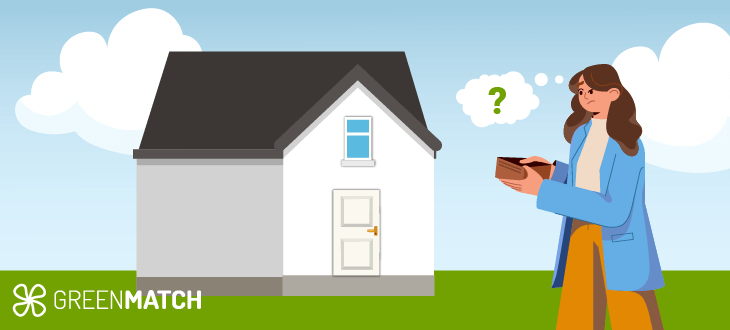
External wall insulation costs on average around £11,000 for a semi-detached 3-bedroom house. Factors such as the size of your property, materials used, complexity of installation, finishing options as well as location will determine the overall price of your home.
Insulation specialists typically charge around £250 per person per day. Labour costs will increase for larger properties or homes with intricate architectural features, irregular shapes, or multiple stories due to the additional time required. Additionally, the location of your home will affect labour costs. Insulation specialists tend to charge more in larger cities where the cost of living is higher.
The type of external insulation material you choose will also affect the overall price. Here are the prices for the top materials:
| Material | Average cost per m2 |
|---|---|
| EPS boards | £10 |
| PIR boards | £12.50 |
| Mineral (Rock) wool | £18.20 |
| Woodfibre | £19 |
| Cork board | £19.50 |
| XPS boards | £21.50 |
External wall insulation grants
Government grants for external wall insulation can significantly reduce the cost of insulating your home, making it a more affordable option for those of you on a budget. These grants support government initiatives to reduce carbon emissions, lower energy bills, and help households transition to more sustainable living.
- The ECO4 scheme requires large energy companies to help low-income or vulnerable households improve energy efficiency. Eligibility depends on factors like income, benefits received, and your home's energy rating. The scheme may cover up to 100% of external wall insulation costs, but some households may need to contribute.
- The Great British Insulation Scheme is a key grant available in England, Wales, and Scotland, offering free or low-cost insulation to homeowners, landlords, and tenants to help reduce energy bills. Tenants must first communicate with their landlord before applying. Homes with an EPC rating of D-G or in Council bands A-D (England) or A-E (Scotland/Wales) qualify.
- Warmer Homes Scotland Scheme fully covers energy improvements like attic insulation, wall insulation, draught proofing, and central heating. It targets households with members over 75 without central heating, terminally ill individuals, or those receiving specific benefits. Homes in Council Tax bands A-F, with floor areas under 230m2, or low EPC ratings are eligible.
- Affordable Warmth Scheme is designed for Northern Ireland, this grant assists low-income individuals in private accommodations with energy efficiency improvements. Eligible applicants include private homeowners or renters with an income of £23,000 or less.
To explore current grants and determine your eligibility, contact your local authority and visit your government's website to learn more about the requirements of each grant.
Materials for external insulation
Choosing the right materials for external wall insulation ensures effective thermal performance, durability, and overall comfort in your home. Different materials offer varying insulation levels, moisture resistance, and ease of installation.
- Polyisocyanurate (PIR) boards
- Extruded polystyrene (XPS) boards
- Expanded polystyrene (EPS) boards
- Mineral (Rock) wool
- Woodfibre
- Cork boards
When choosing insulation materials, it's essential to consider several vital qualities:
- Thermal efficiency: High thermal efficiency, measured by R-value, is crucial for keeping your home warmer in winter and cooler in summer, leading to lower energy bills.
- Moisture resistance: Materials that resist moisture prevent water from penetrating the insulation and the wall structure, avoiding dampness, mould growth, and structural damage, which prolongs the life of your insulation.
- Durability: Insulation exposed to harsh weather, temperature fluctuations, and physical impacts must be durable to remain effective over time and reduce the need for repairs or replacement.
- Fire resistance: Materials with high fire resistance help prevent the spread of flames, enhancing home safety.
- Breathability: Breathable insulation allows moisture to escape while preventing water ingress. It is essential for older or historic buildings to maintain their natural moisture balance and avoid condensation and structural damage.
- Compatibility with external finishes: The insulation material must be compatible with your chosen external finish, such as insulation render or cladding, to ensure performance and aesthetic appeal.
In addition to these qualities, consider whether the material is sustainable and cost-effective to balance performance with environmental impact and budget. These factors help you select the best material for your external wall insulation needs.
What is the best external wall insulation?

When selecting the best insulation for external walls, various factors like sustainability, breathability, budget, thermal efficiency, and durability come into play. It's important to recognise that there is no universal solution, and you'll need to prioritise the qualities that matter most to you. Here's a breakdown of the top materials based on these criteria:
Best for budget
EPS boards are the most cost-effective material for external home insulation; on average, you will spend around £10 per m2. It provides a decent R-value at 4 to 4.5 per inch at a lower price point than other materials. While it’s less environmentally friendly than cork or wood fibre, EPS is lightweight, easy to install, and has good moisture resistance, making it a practical choice for those on a budget.
Best for thermal efficiency
PIR boards have one of the highest R-values among insulation materials, ranging between 5.6 to 7 per inch, making them the most thermally efficient option. This material is fire-resistant and easy to install. However, it's important to note that the R-value can decrease in colder temperatures, and the material is susceptible to water absorption. Therefore, it is essential to have a sufficient water barrier and additional waterproofing when using PIR boards for external wall insulation.
Best for breathability
Wood fibre insulation is very breathable, allowing moisture to escape while keeping the interior dry. It is an excellent breathable insulation for stone walls as it helps manage moisture, prevent dampness, and maintain structural integrity. It is also eco-friendly and burns slowly. However, it has a lower R-value than other materials at 3.5 per inch.
Best for durability
XPS is known for its high durability and compressive strength, making it suitable for areas exposed to mechanical stress. It is also highly moisture-resistant, which helps prevent water damage and prolongs the insulation’s lifespan. On average, XPS can last up to 50 years, but with proper installation, it can last a lifetime. It also has a high R-value of 5 to 6 per inch. It absorbs less than 1% of water, making it an ideal moisture-resistant material. However, XPS is one of the most expensive materials available at £21.50 per m2 and is highly flammable, releasing toxic chemicals as well.
Best for sustainability
Manufacturers make cork boards from the bark of cork oak trees, a natural and renewable resource. Harvesting the cork doesn't require cutting down trees, and the material is biodegradable, recyclable, and environmentally friendly. With an R-value of 3.7 per inch, cork boards are slightly more thermally efficient than wood fibre. In addition, cork is naturally resistant to fire and water absorption, making it an excellent choice for external wall insulation.
What walls are suitable for external insulation
When considering external insulation for your home, it's important to determine whether your walls are suitable for this type of insulation. External wall insulation involves adding a layer of insulating material to the outside of your home, which is then covered with a protective render or cladding.
This method is highly effective for improving energy efficiency, but it is not suitable for all types of walls. Here’s a breakdown of which walls are most suitable for external insulation.
Solid stone walls
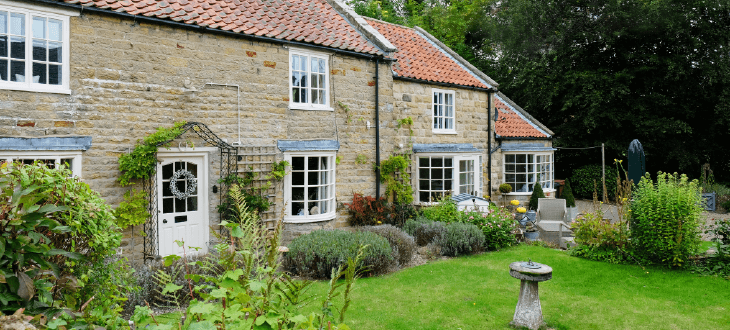
Many traditional homes in the UK have stone walls, often solid and either rendered or left with exposed brickwork. While some stone walls in older homes are solid, more modern stone walls may have cavities. It's essential to determine whether your walls are solid or cavity walls before proceeding with insulation.
Traditional stone walls in the UK are designed to absorb and release moisture, preventing decay of the building fabric. Any insulation material you choose must allow this natural process to continue. Stone walls add character to a home, and adding external insulation could alter the aesthetic of your solid stone wall. Additionally, if you live in a listed building with solid stone walls, you may be denied permission for external insulation due to its impact on the building's appearance.
External solid walls
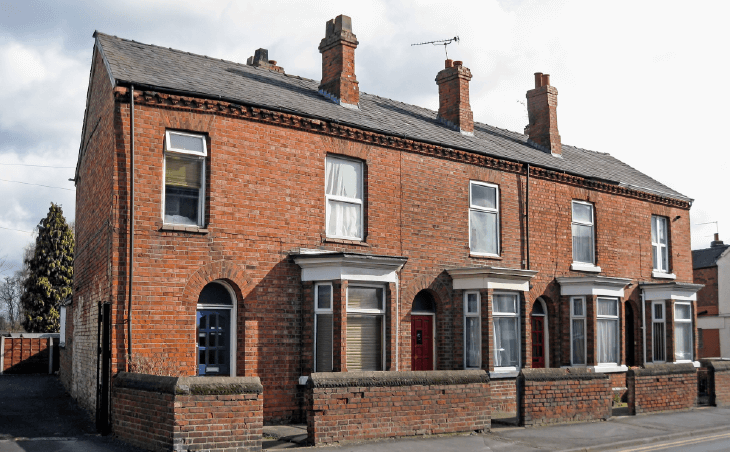
Solid walls consist of a single layer of brick, stone, or concrete with no gap between the interior and exterior. You’ll often find this type of wall in older homes, particularly those built before the 1920s, like Georgian, Victorian, and Edwardian houses. Because solid walls typically lose more heat than cavity walls, they are ideal candidates for external insulation. External insulation can significantly enhance thermal efficiency, reduce energy costs, and improve comfort.
Timber framed walls
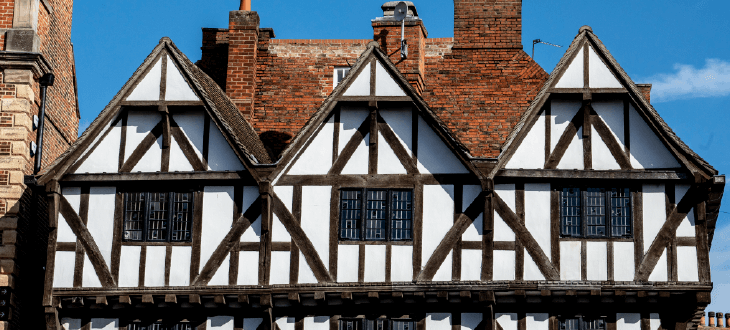
Timber-framed walls consist of a wooden structural frame supporting the building, with various materials used for cladding or filling. Tudor architecture often features timber-framed homes, but they also exist in modern constructions. Between the 1920s and 1970s, builders constructed around 108,000 timber-framed homes.
Like stone walls, it's essential to determine whether your timber-framed walls are solid or have cavities, with more modern homes typically featuring cavities. Tudor homes, listed as buildings in the UK, cannot have external insulation added due to preservation regulations.
You can insulate timber-framed walls externally, but it's crucial to choose insulation materials that are compatible with the timber structure. To prevent moisture buildup and potential damage to the wood, external wall insulation installers often recommend using breathable insulation.
Concrete walls
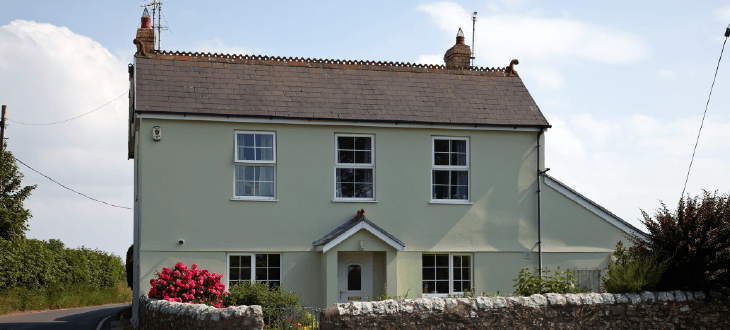
Approximately 284,000 homes in the UK are constructed from concrete, mainly built during the 1950s to 1960s. Although most older concrete homes are solid, newer homes made of this material may have cavities, so it's important to check the width of your walls to determine if they are solid.
If the walls are solid, they are suitable for external insulation. External insulation can help reduce the natural thermal inefficiencies of concrete or block construction, making the building more energy-efficient.
Can you add external wall insulation to cavity walls?
It’s generally not recommended to add external wall insulation to cavity walls. The reason is that cavity walls are designed to be insulated within the cavity itself, which effectively increases thermal efficiency. Cavity walls also have ventilation, which allows heat that penetrates the internal layer to escape into the atmosphere, rendering external insulation almost ineffective.
Additionally, adding external insulation can cause issues like trapped moisture, leading to dampness and potential structural damage. While it is possible to add external insulation to a cavity wall, it is usually unnecessary and can create more problems than it solves.
Building regulations for external insulation
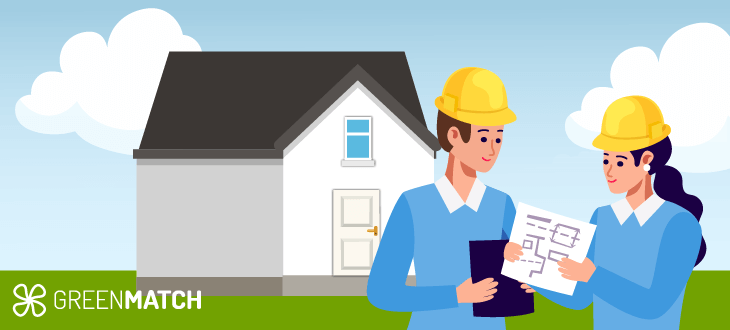
When considering external wall insulation for your home, knowing the relevant building regulations is essential to ensure your project complies with legal requirements. Under the rules, if 25% or more of the exterior walls are insulated, they must meet current building standards.
In the UK, external wall insulation usually falls within permitted planning. However, some factors must be considered before starting this project. This doesn't apply to protected buildings or homes on a conservation site; planning permission is required for these types of homes.
- Thickness: On average, it is advisable to aim for a 50mm to 100mm thickness of your wall insulation material. This ensures that the insulation does not exceed the maximum U-value.
- U-value: Building regulations require external insulation not to exceed 0.30 W/m2K. A solid brick wall, typically 225mm thick, has a U-value of 1.20 W/m2K, and a 450mm stone wall has a U-value of 1.50 W/m2K. Therefore, the chosen material should reduce the U-value to meet the recommended standard.
- Fire safety: The external home insulation material should meet fire safety standards within the UK.
- Moisture control: The insulation should include measures to prevent moisture buildup, which can lead to dampness, mould growth, and structural damage. One such measure is adding proper ventilation to the walls.
- Structural integrity: When adding external insulation and cladding to a building, it is important to assess whether the existing structure can support the added weight without compromising the building's integrity.
- Oversail licence: If your home closely touches a public highway, including the pavement, and your exterior wall insulation will project over it, you will need to apply for an oversail licence.
Despite external wall insulation being considered permitted development, you still need to contact your local authority to assess if it falls under permitted planning.
How to insulate external walls
Insulating external walls is a complex process, and it is considered one of the more challenging types of insulation to install. It involves adding a layer of insulation to the outside of your home, covered with a protective finish such as render or cladding. Here’s a simplified guide on how to insulate external walls:
- Assess walls: Identify whether your walls are solid or cavity, ensuring they are in good condition and free from significant cracks, dampness, or structural issues. Repair any damage before installing insulation.
- Render test: Test the exterior render to support the insulation.
- Remove pipes: Temporarily remove external pipes and safely store them to prevent damage during installation.
- Protect windows: Apply a protective film over windows to avoid damage during the insulation process.
- Install insulation: Use adhesive to attach insulation boards to the external walls, fitting them snugly to avoid thermal bridging and gaps.
- Fixing anchors: Secure the insulation boards with mechanical fixing anchors.
- Reinforce with mesh: Apply a layer of glass mesh using the fixing anchors to reinforce the insulation.
- Add primer: Paint a primer onto the installed layers to help the final render adhere and provide a waterproof barrier.
- Apply final finish: Add the final render for a decorative and protective finish.
While understanding how to insulate external walls is essential, DIY external insulation is not recommended due to the complexity involved. Working with reliable insulation specialists is vital. GreenMatch can connect you with top insulation specialists in your area. By filling out our 30-second form, we can provide up to four free quotes from the best insulation professionals. Click below to learn more.
Fill in the form in just 1 minute
FAQ
Yes, external wall insulation is a good idea. It significantly improves energy efficiency by reducing heat loss, leading to lower energy bills and a reduced carbon footprint. Additionally, it enhances the comfort of your home and can increase property value.
The best insulation for outside walls depends on your preference, but polyisocyanurate (PIR) boards are the best insulation material for thermal efficiency.
You can insulate your exterior walls by adding a layer of insulation material to the outside of your home, reinforcing it with a layer of glass mesh, and then a protective finish such as render or cladding. This process improves energy efficiency and requires professional installation to ensure proper application and compliance with building regulations.
External wall insulation should typically be between 50mm and 100mm thick, depending on the insulation material used and the desired thermal performance. The thickness must meet building regulations, aiming for a U-value of 0.30 W/m2K or lower to ensure effective energy efficiency.
External wall insulation costs an average of around £11,000 for a three-bedroom semi-detached home. Factors such as the size of your home, the type of insulation material used, the complexity of the installation, and your location will impact the overall cost.

Caoimhe is an experienced content writer and researcher who is passionate about providing accessible information to every reader. With a background in English literature and Sociology, she combines the two disciplines to create cohesive, well-thought-out, and well-informed pieces.
We strive to connect our customers with the right product and supplier. Would you like to be part of GreenMatch?

- External Wall Insulation: Pros & Cons, Costs, Grants
- What is external wall insulation?
- Advantages and disadvantages of external wall insulation
- External wall insulation cost
- External wall insulation grants
- Materials for external insulation
- What walls are suitable for external insulation
- Building regulations for external insulation
- How to insulate external walls
- FAQ
